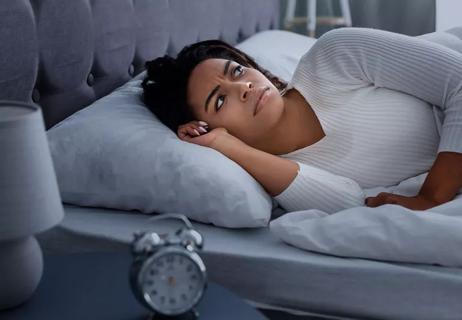Keeping a sleep diary and seeing a sleep specialist can help you stay asleep and get the ZZZs you need

There may be no better feeling than waking up refreshed after an uninterrupted night of sleep. Unfortunately, this type of deep slumber is only a dream for millions of Americans with insomnia.
Advertisement
Cleveland Clinic is a non-profit academic medical center. Advertising on our site helps support our mission. We do not endorse non-Cleveland Clinic products or services. Policy
“Most people think of insomnia as difficulty falling asleep,” says behavioral sleep medicine psychologist Alicia Roth, PhD. “But maintaining sleep — in other words, staying asleep — is another common type of insomnia.”
This is known as sleep maintenance insomnia. An estimated 1 in 5 people with insomnia experience the sleep maintenance type. So, what is it and how can it be helped? Dr. Roth explains.
Sleep maintenance insomnia occurs when you wake in the middle of the night but can’t fall back to sleep. Because this sleep disruption occurs midway through your sleep cycle, it’s also known as middle insomnia.
The timing of middle insomnia differs from:
It’s also possible to have one or more sleep disruptions during the night (mixed insomnia).
Three signs of sleep maintenance insomnia include:
Advertisement
“Sleep maintenance insomnia doesn’t always have an underlying medical or psychological cause,” says Dr. Roth.
But sleep maintenance insomnia can also be due to other conditions that wake you in the middle of the night, like:
“Sleep maintenance insomnia may occur because your sleep drive is running out in the middle of the night. Every hour you are awake, your sleepiness or drive for sleep (called the homeostatic sleep drive) increases,” explains Dr. Roth. “There are many behaviors that can weaken your sleep drive, including having caffeine in the afternoon, napping too late in the day, or going to bed too early.”
While there isn’t a primary cause for sleep maintenance insomnia, these factors can increase your risk:
The first step to getting better sleep is seeking help.
“Too many people think disrupted sleep is something they must live with,” says Dr. Roth. “Your sleep needs change over the years, but that doesn’t mean you have to settle for poor quality sleep.”
These three steps can help determine what’s interrupting your slumber:
Depending on your symptoms, medical history and current life events, your provider may refer you for a sleep study. A sleep study identifies sleep disorders and other disruptive conditions such as:
Behavioral sleep medicine specialists have advanced training in identifying and addressing behavioral, psychological and physical factors that disrupt sleep. A provider may gather information about your:
They’ll also work with you on identifying your ideal circadian rhythms and teach methods to regulate your homeostatic sleep drive.
A sleep diary is a helpful tool for tracking sleep patterns. You can also use a wearable device like a smartwatch to monitor sleep. Write that information into your sleep diary each morning to share with your provider, along with how you’re feeling when you’re going to bed and how you feel when you wake.
Advertisement
A sleep diary keeps track of:
Taken together, the above steps can help your healthcare provider determine what’s disrupting your sleep and any potential solutions that can help you get back to getting a full night’s rest.
In general, studies show that sleep therapy — specifically, cognitive behavioral therapy for insomnia (CBT-i) — is the most effective way to improve sleep when you have sleep maintenance insomnia.
Cognitive behavioral therapy (CBT) is a type of psychotherapy (talk therapy) that addresses how your thoughts, habits and behaviors interact to affect your mental health and outlook.
CBT for insomnia, or CBT-i, is a specialized form of CBT that identifies and addresses patterns that affect sleep.
“This therapy is the gold standard of treatment for all forms of insomnia,” says Dr. Roth. “It combines sleep education and therapy techniques to identify behaviors, emotions and beliefs that contribute to poor sleep, and recalibrate them to improve sleep.”
Advertisement
CBT-i focuses on these two key components:
1. Behaviors and habits, like:
2. Your relationship to or thoughts on sleep, like:
CBT-i also incorporates sleep meditation tools, which help your body prepare for sleep and stay asleep. These tools include:
If you have sleep maintenance insomnia, focus on the following to avoid worsening your insomnia:
Advertisement
Some additional steps you might take to overcome insomnia may help in small ways, but they won’t overall fix your sleep maintenance issues. For instance:
Most people with sleep maintenance insomnia enjoy improved slumber after four to eight in-person CBT-i sessions over a six- to eight-week period. But it can be challenging to find a professional with CBT-i training.
Ask your healthcare provider for a referral, rely on other resource directories like the Society of Behavioral Sleep Medicine. Roughly 3 in 4 people with insomnia who complete this six-week web-based program see meaningful, sustained improvements in the severity of insomnia symptoms, according to a Cleveland Clinic study.
“CBT-i requires more effort than taking a pill, but it’s more effective at improving sleep quality,” encourages Dr. Roth. “In a few weeks, this therapy can greatly enhance your relationship with sleep.”
Learn more about our editorial process.
Advertisement

Pain, light exposure and anxiety are just a few factors that could be waking you up in the middle of the night

Create a consistent wake-up schedule, don’t nap too long and follow the ‘20-minute toss-and-turn rule’ when you can’t sleep

If you’re feeling short of breath, sleep can be tough — propping yourself up or sleeping on your side may help

Changing hormones, mental health issues and a higher risk for sleep disorders can all impact women’s sleep needs

This social media sleep hack with tart cherry juice and magnesium could be worth a try

It’s normal to oversleep occasionally, but sometimes, there might be an underlying cause

Tame racing thoughts with breathing exercises, screen time limits and connecting to your body

How to know if your body’s internal clock is out of whack

Start having sex about 72 hours before ovulation, then at least every other day during your fertile window

Attachment theory suggests that your earliest relationships shape connections throughout your life

It isn’t a recognized mental health disorder, but research shows that problematic social media use can negatively affect your mental health, self-esteem and sleep